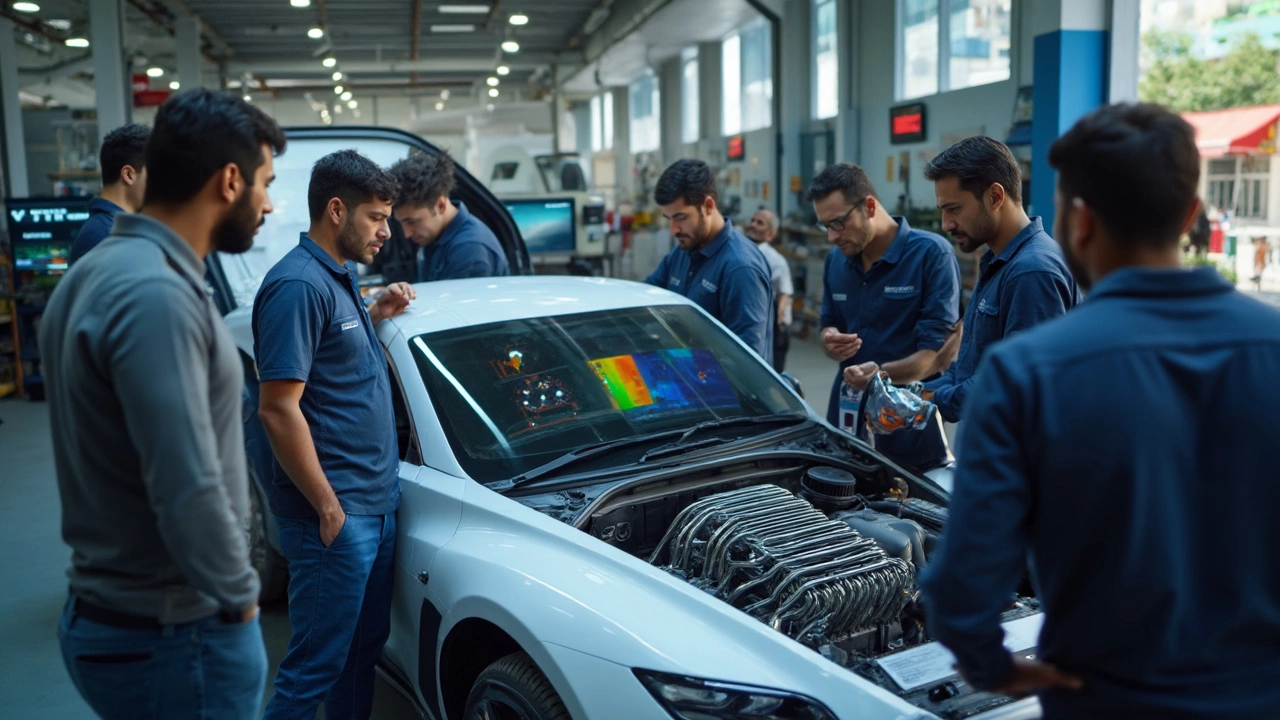Pop open the hood of a brand-new car and you’ll still probably spot something that looks a lot like the radiator your granddad used to curse at. But does every single car out there still use a radiator? It seems like technology has changed almost everything else—so it’s a fair question.
If you drive a traditional gas or diesel rig, the answer is: yep, you’ve still got one. The radiator might be sleeker and tucked away behind plastic covers, but its job hasn’t changed much. It cools the engine by transferring heat from hot coolant to the air outside, using a bunch of tiny fins and a steady breeze from the front grill or a fan. Skip radiator maintenance and you just might find yourself sweating roadside with steam billowing from under the hood.
But what about all these new electric cars I keep seeing in town? The story’s not as straightforward. Some don’t need a classic engine-style radiator at all, while others—especially hybrids—run with their own take on liquid cooling. That doesn’t mean you can forget about cooling systems; it’s just the technology is shifting as fast as the rest of the car world.
- Why Cars Needed Radiators in the First Place
- Radiators in Modern Gas and Diesel Cars
- The Electric Car Shift: Do They Have Radiators?
- Hybrids and Plug-ins: Cooling Demands Explained
- What Happens If Your Radiator Fails?
- Tips for Keeping Your Cooling System in Top Shape
Why Cars Needed Radiators in the First Place
Combustion engines produce a ton of heat. When gasoline or diesel burns inside the engine, temperatures can shoot up to around 2,000°F (that’s over 1,000°C). That much heat isn’t just uncomfortable—it’s enough to wreck engine parts, melt metal, and turn oil into sludge in no time. Early car makers knew engines would only last a few miles without something to pull this heat away.
This is where radiators came in. They’re basically just metal boxes filled with narrow tubes and cooling fins. Engine coolant—a mix of water and antifreeze—picks up heat as it flows around the engine. Then it gets pumped through the radiator, where the hot coolant loses its heat to the air passing through those tiny fins.
Back in the day, overheating was a super common problem. Without a working radiator, car owners regularly stranded themselves on the side of the road waiting for their rides to cool off. Even now, a failed radiator is still a top cause of roadside breakdowns, showing how important this simple tech really is.
- Engines run hottest right after you push them hard—say, during highway driving or climbing hills.
- Engine damage from overheating can cost thousands to repair: warped heads, blown gaskets, or worse.
To put some numbers behind this, check out how much heat a typical car radiator needs to handle:
| Engine Type | Average Heat Produced (BTUs/hr) | Average Radiator Size (liters) |
|---|---|---|
| Small 4-cylinder (Compact Car) | 60,000–80,000 | 1.0–1.5 |
| 6-cylinder (SUV/Truck) | 90,000–120,000 | 2.0–2.5 |
| 8-cylinder (Performance/Truck) | 130,000–160,000 | 2.5–3.0 |
The car radiators themselves have hardly changed in basic design over a century. If your engine gets too hot, everything else stops mattering real quick. Keeping it cool? That’s the whole game.
Radiators in Modern Gas and Diesel Cars
Gas and diesel engines still count on the radiator as the backbone of their cooling system. Under the hood, it's usually a big metal or aluminum box (sometimes plastic, which is cheaper but less durable), hidden behind the grill. Its main gig is simple: pull heat out of the engine coolant and dump it into the outside air. If that heat doesn't go anywhere, your engine will overheat—fast.
Most car radiators these days use thin, flat tubes and a ton of little fins to spread out the heat. A fan helps push air through when you're stuck in traffic or not moving fast enough. When you’re cruising down the highway, air flows through the grill and cools everything without much help from the fan. It's pretty efficient, but it does need the right type of coolant and enough airflow to work.
Here’s what you’ll find in pretty much every modern radiator setup:
- A radiator core (the main block with all those tiny tubes and fins)
- Upper and lower tanks (where coolant comes in hot and leaves cooled off)
- Radiator cap (keeps the whole system sealed and pressurized)
- Hoses connecting the radiator to the engine
- Electric or belt-driven fans
Modern radiators often include a built-in transmission cooler. That means one less part to break and helps cut down on repair bills. Manufacturers switched from copper and brass to aluminum mostly because it’s lighter and cheaper, plus aluminum dumps heat pretty quickly.
| Average Radiator Lifespan | Common Radiator Failures | Replacement Cost (USD) |
|---|---|---|
| 8-15 years | Leaks, clogging, corrosion, fan failure | $400 - $900 |
One quick tip—modern radiators don’t need their coolant swapped every year like old ones did. Most newer cars have long-life coolant good for 5 years or even 100,000 miles, but you should definitely check your owner's manual for the right interval. Don't forget to look for wet spots under your car or a low coolant warning on your dash. Catching small leaks early can save you a boatload later.
The Electric Car Shift: Do They Have Radiators?
If you drive a classic gas-powered car, you've got a radiator—no doubt. But with electric vehicles (EVs) like Teslas, Rivians, or even the Ford F-150 Lightning, things get a bit less obvious. People often assume since there's no regular engine, there's no need for a cooling system. Surprisingly, that’s not the case.
Electric cars may not have a traditional engine, but they still create heat. Key parts like the battery pack, inverter, and electric motor can all get hot. Too much heat is bad news, especially for those huge batteries—heat can shorten their life or even cause big safety issues. So, most modern EVs use a cooling system, though it looks different from what you’d find in a gas car.
Most electric cars have a liquid cooling system with a radiator, pumps, and hoses built in. Instead of cooling an engine, these systems chill the battery and electronics. Take the Tesla Model 3: it has a "thermal management system" that includes a radiator and runs coolant through the battery pack, power electronics, and motor. Without this, battery life would tank quickly during summer drives or while fast-charging.
| EV Model | Cooling System Exists? | Type of Cooling |
|---|---|---|
| Tesla Model 3 | Yes | Liquid-cooled radiator |
| Nissan Leaf | Rare (older models) | Air-cooled (older); liquid-cooled (newer) |
| Chevy Bolt | Yes | Liquid-cooled radiator |
| Porsche Taycan | Yes | Liquid-cooled radiator |
Here’s why the shift matters: a car radiator isn’t just about engine cooling anymore. It’s part of keeping complex electronics happy and safe. The market has learned this the hard way; some early EVs used air cooling alone (looking at the first-gen Nissan Leaf), and those batteries wore out fast in hotter climates. Most manufacturers responded by switching to liquid cooling systems, often using radiators that look like smaller versions of the traditional type.
- If your car supports fast charging, odds are it’s liquid-cooled.
- Batteries need to stay in a goldilocks zone—not too hot or cold—or you’ll notice performance drops.
- Check your owner’s manual. Even if you don’t hear the radiator fan, maintenance and coolant level checks still matter.
It comes down to this: radiators haven’t disappeared. They’ve just evolved with the cars themselves. So, if you pick an EV, don’t ignore its cooling system—it’s just as vital as in any traditional ride.

Hybrids and Plug-ins: Cooling Demands Explained
Hybrid and plug-in hybrid cars are pretty unique because they mix a traditional gas engine with electric power. That actually means even more stuff under the hood needs to stay cool—not just the engine, but also batteries, power electronics, and sometimes even the electric motor. Most people don’t realize it, but these parts can heat up just as much as anything in a full gas car, especially if you’re zipping around in hot weather or stuck in traffic.
The cooling setup in a hybrid usually features more than just a basic car radiator. Many hybrids actually have separate cooling loops. For example, Toyota’s popular Prius has a standard engine radiator plus an extra loop just for the hybrid system (which cools the inverter, electric motor, and battery if needed). Plug-in hybrids like the Chevrolet Volt use liquid-cooled batteries to prevent them from getting too warm, since overheated batteries lose efficiency really fast and can wear out long before the car itself does.
Electric fans, small radiators, and even heat exchangers often work together in these cars. If the battery gets too hot, coolant runs through special channels to draw off the heat, then moves it to a dedicated mini-radiator, away from the engine’s own cooling flow. This helps everything stay at the right temp, even when both the gas and electric halves are working hard.
It’s not all high-tech wizardry, though. Regular coolant flushes, keeping an eye out for leaks, and not skipping recommended maintenance on your hybrid are just as important here. Because if one part of this complex system goes down, you could end up with a warning light—or worse, a big repair bill. Bottom line: hybrids and plug-ins do still use radiators, but they often double up with specialized cooling parts you won’t find in an old-school car.
What Happens If Your Radiator Fails?
If your car radiator throws in the towel, things can go south real fast. Without it, your engine gets hotter than a summer dashboard, and you can’t ignore the risks. When the radiator fails, it messes with the entire cooling system, leaving your engine defenseless against heat.
The first thing you might notice is the temperature gauge climbing higher than normal. Some cars will even flash a warning light or crank on a buzzer. If you see steam pouring out from under the hood or catch a whiff of sweet-smelling coolant, you’re already in the danger zone. Driving with an overheating engine can do major damage in minutes, like warping the cylinder head or killing your head gasket. That’s the kind of trouble that racks up a bill even your cat would hiss at.
- Engine Overheating: It can reach dangerous temps quickly. Once it gets past 240°F (115°C), engine parts start wearing out fast.
- Poor Performance: The car might start running rough, lose power, or even shut off if it overheats.
- Coolant Leaks: Radiator failure can lead to obvious puddles under your parked ride—green, orange, or pink, depending on coolant type.
- Internal Damage: In severe cases, you’re looking at warped pistons, blown gaskets, or a cracked engine block.
Here’s a quick look at what can go wrong depending on how long the car runs hot:
| Time Overheated | Likely Damage | Average Repair Cost (USD) |
|---|---|---|
| 0-5 minutes | Minor engine stress, warning lights | $50 - $200 |
| 5-20 minutes | Warped head, possible gasket damage | $700 - $1500 |
| 20+ minutes | Major engine failure, cracked block | $2000+ |
If you think your radiator is on the fritz, don’t try to tough it out. Pull over safely and let the engine cool. Open the hood once things have cooled down, but don’t ever take the radiator cap off while it’s hot—it can burn like crazy. Call a tow if you need to. Fixing a leaky radiator beats the price tag on a new engine every time.
Tips for Keeping Your Cooling System in Top Shape
If you want your car to run smoothly and stay out of the repair shop, don’t ignore the cooling system. Most big engine issues can be traced back to overheating, which often means trouble with car radiators or their sidekicks—hoses, fans, and coolant. Here’s how to stay out of the hot zone.
- Check your coolant level every month. Pop the hood and make sure the fluid sits between the “min” and “max” lines on the reservoir. Low levels mean there’s a leak or it burned off—neither is good. Don’t just use water. Always grab a proper mix for your car, since coolant does a much better job resisting boiling and freezing.
- Give the radiator a visual once-over. Look for puddles under your car, crusty green or orange stains around fittings, or spots that look corroded. A quick look now can prevent an overheated engine later.
- Change your coolant on schedule. Most manufacturers recommend swapping out your coolant every 30,000 to 60,000 miles, but check your owner’s manual for your exact number. Old coolant can turn into sludge, which means poor cooling and expensive repairs.
- Inspect your radiator cap. A worn-out cap won’t hold pressure, which can cause your system to overheat. The spring under the cap should feel tight. If it looks rusty or cracked, grab a new one. It’s cheap insurance.
- Keep the front grill and radiator fins clear. Dirt, bugs, and debris block airflow. If your engine’s running a little hotter than usual, hose the front grill and fins off (carefully—don’t bend the fins). Your radiator needs to breathe.
- Listen for the fan. On a warm day, after the engine’s hot, pop the hood and listen for the cooling fan kicking on. If it’s not working, your radiator can’t do its thing, especially in slow traffic.
- Watch your temperature gauge. Most cars have a dashboard gauge that’ll point out trouble before things go nuclear. If it rises above normal, pull over. Don’t gamble. Engines can’t handle heat for long.
Staying on top of these basics gives your cooling system its best shot at a long, pain-free life. Fixing a radiator leak or changing the coolant might sound boring, but trust me—sitting on the shoulder with a steaming hood is way less fun. If you’re not sure, get a trustworthy mechanic to take a peek at your next oil change.




